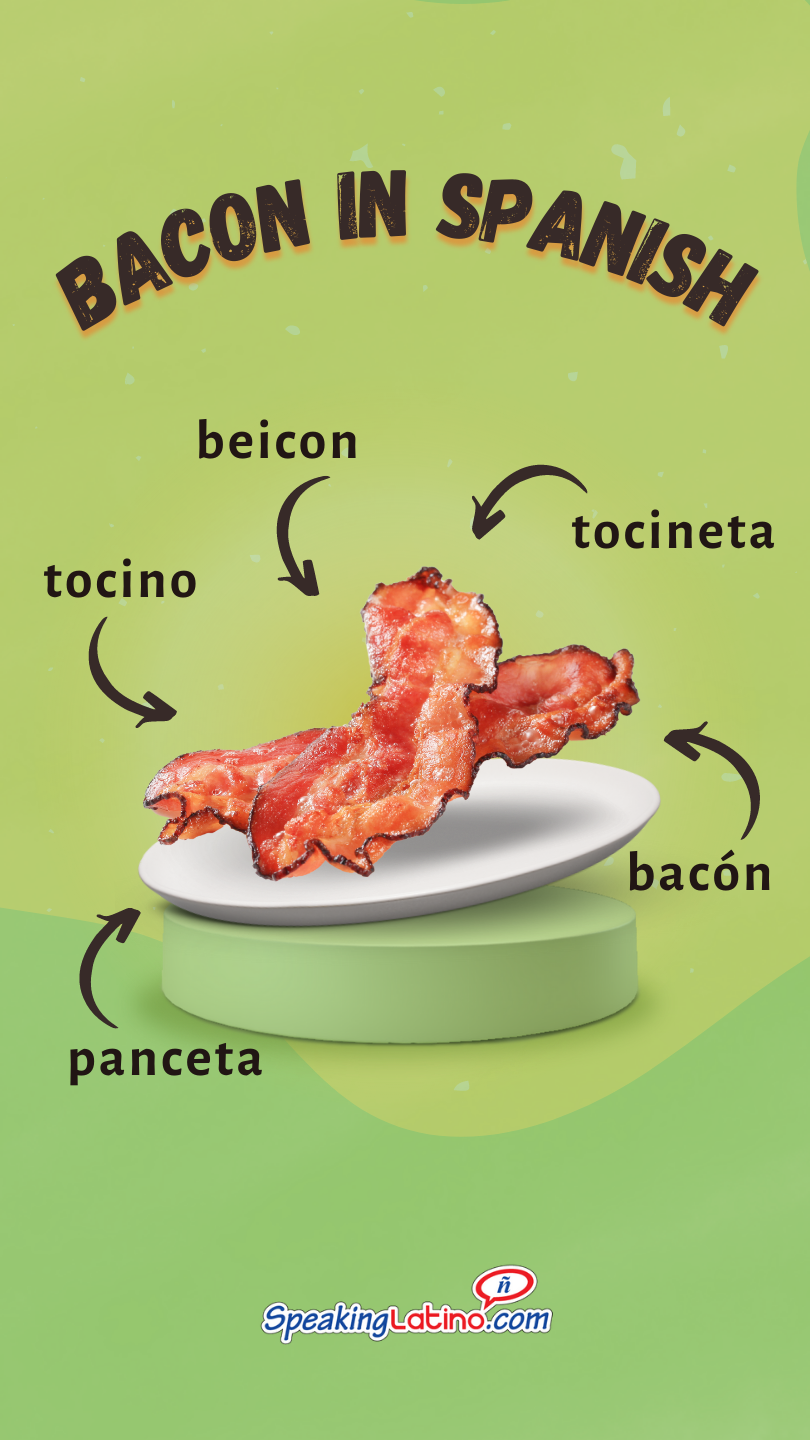The words tocino, tocineta, beicon, bacon, bacón and panceta all mean bacon in different countries.
When asked the simple question “How do you say bacon in Spanish?” there is no quick answer. The Spanish word for bacon varies from one country to the next as you can see from the list above.
The Royal Spanish Academy Dictionary lists the word for bacon as tocino. But according to the Diccionario de Americanismos the word tocineta is used in Nicaragua, Costa Rica, Panama, Cuba, Dominican Republic, Puerto Rico, Colombia, Venezuela, Ecuador, Bolivia, and Uruguay.
Another word is panceta, which is a word derived from panza, or belly. To complete the list, I will add beicon and bacón, which are borrowed directly from the English bacon.
So what is bacon in Spanish-speaking countries?
Good news, if you see “tocino” on a menu you are going to get some sort of cured pork product but it might not be what you really want.
While in Latin America, you’ll also notice bacon isn’t mainly a breakfast food. We adore Spain specifically because how could you hate “second breakfast” around 10am? Which puts lunch about 3pm – there’s so much to love about Latin America food culture. Including the fact that bacon is a star all day long.
One other important difference to mention is that bacon in Spain is not served crispy. You would need to specifically request it by saying “bacon crujiente por favor.”
How Do You Say Bacon In Spanish?
Let’s talk about the king of the American breakfast – BACON and its many forms. In the United States, the average person consumes 18 pounds of bacon each year, mostly at breakfast time.
In English you might ask a server: Do you have bacon?
In Spanish you’d say: Tienes tocino?
When your delicious plate arrives, the bacon might not be the same.
In Latin America, you’ll find tocineta meat, which has a high fat content so the taste is described like bacon but VERY intense. While the Spanish word “tocino” will work when ordering/shopping for bacon, the Spanish words tocineta, beicon, and panceta are also similiar but a slightly different taste. Don’t worry, you’ll still get pork but your tastebuds might be expecting something else because of the curing process.
How do you spell bacon in Spanish?
Personally, I’ve seen it written as bacon (pronounced just like in English), bacón (pronounced like bahhcon, with the A sounding like when you open your throat for the doctor “say ahhhhh”) and beicon.
Panceta, Turkey Bacon & Jamón ibérico
Pancetta (some call it the Italian bacon) and traditional American bacon can be used interchangeably in Latin American dishes – but it’s still pork. The main difference between the two is that bacon is smoked, and pancetta isn’t.
Spanish omelets with panceta or ‘tortilla de patatas’ or ‘tortilla española’ are often served as tapas in restaurants and bars in Spain.
Turkey bacon is a thing in Latin America too, if you are trying to avoid pork and cut your calories – it can be done. You’ll want to know the Spanish word combo ‘tocino de pavo’ which is “turkey bacon”.
¿Qué hay de almorzar? – Tocino de pavo con huevos.
What’s for lunch? – Turkey bacon and eggs.
What Is The Famous Spanish Bacon Called?
Jamón ibérico – The most expensive ham in the world.
Hold up. I’m not sure you should be calling this stuff ‘bacon’ but if you fancy yourself a bacon aficionado, find some highbrow jamón ibérico. It’s a whole artisanal experience, special pigs, special acorn diets, it takes 2 years to make etc. etc.
This type of ham product is usually seen in bars & restaurants or served at special occasions in Latin America. Only a few US brands have been able to withstand the impossible FDA regulations coupled with already rigid quality standards of sliced Ibérico ham in Spain, so it’s not easy to find stateside.
If you love bacon (and don’t mind the high price tag), look for something like jamón ibérico with beer and pan con tomate on the menu. (Pan con tomate – think bread with a tomato topping which is common in bars throughout Spain, where it is also known as pan tumaca.)
Breakfast vocabulary to order with your bacon
Let’s look at breakfast. A sandwich or bread with coffee and fruit is typical for the first meal of the day. The sweet stuff is usually saved for later with coffee in the afteroon but really, there are no rules.
Here are the most common Latin American breakfast dishes:
Cafe con leche – coffee
Tostada – toasted bread w/ toppings
Churros – cinnamon sprinkled fried dough or porras in Madrid ( a denser version)
Huevos – eggs
Tocino – bacon – In some Latin American countries like Colombia, Cuba, Mexico, Venezuela, or Panamá, you’ll get thick cut pork bacon which is called la tocineta.
Spanish Words for BACON

When ordering a side of bacon at a restaurant, you may want to specify how you would like it cooked.
In English: A little crispy.
In Spanish: un poco crujiente
In English: really crispy bacon
In Spanish: tocino realmente crujiente
No matter what your tastes are, there is sure to be a Spanish dish in Latin America that you’ll love – with or without bacon. So don’t be afraid to explore and try something new!
Check out these other articles about the Spanish Language.